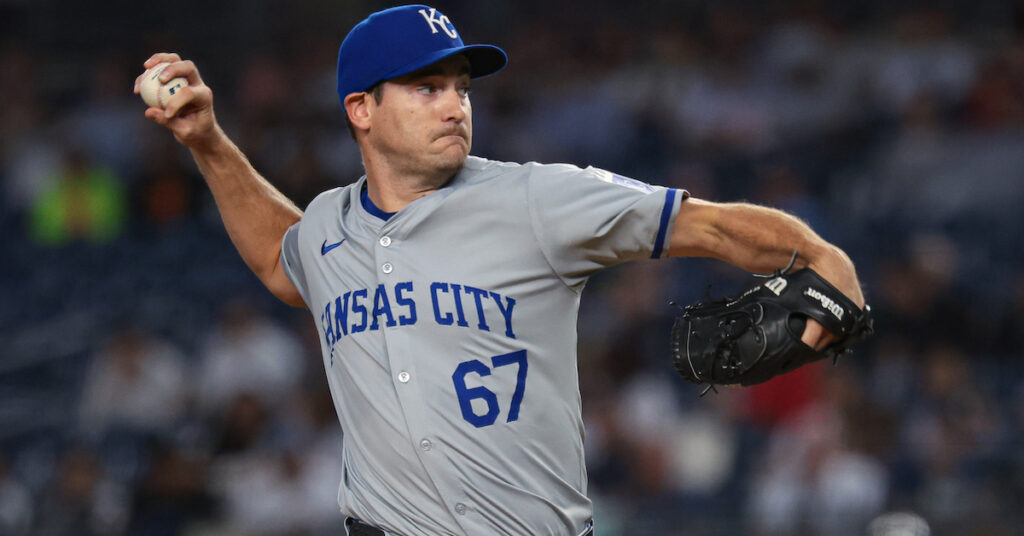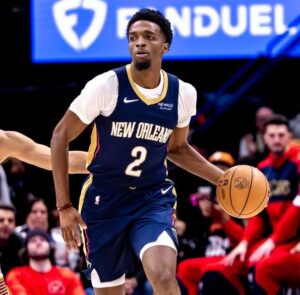
On Tuesday night, while much of the country tuned in to see Kamala Harris debate Donald Trump, I watched an even more lopsided performance from the upper deck at Yankee Stadium, where the Royals’ Seth Lugo utterly dominated the Yankees, holding them to just three hits, walking none and striking out 10 over seven innings in a 5-0 Kansas City win. Through six innings, the only Yankee to reach base was Gleyber Torres, who blooped soft singles into center field on Lugo’s fifth pitch of the game and then, roughly an hour and 20 minutes later, on his 86th pitch; in between, Lugo retired 17 straight hitters. It was the latest in a season full of great outings from the righty, who at 34 years old is having a career year while pushing the Royals toward their first postseason berth since 2015.
Lugo’s seven scoreless frames ran his total to a major league-leading 193 innings while lowering his ERA to 2.94, second in the AL behind only Tarik Skubal. Meanwhile, he’s third in WAR with 4.4, 0.2 behind teammate Cole Ragans, fifth in FIP (3.27), seventh in walk rate (5.8%), and eighth in strikeouts (169) despite punching out hitters at a modest 21.7% rate. He’s also tied with Skubal for the league lead in wins (16), and so by our Cy Young Projection model and its multiple variants, his suite of stats puts him second in the AL to Skubal and a comfortable margin ahead of Ragans, Logan Gilbert, and Framber Valdez. All of this is happening in the first year of a three-year, $45 million contract he signed with the Royals last December, and in just his third season as a starter after largely being typecast as a workhorse reliever during his seven seasons with the Mets (2016–22).
Knocking back a couple of beers from my partial season ticket group’s usual perch in Section 422 affords a different perspective than in the press box or at home. So when Sports Reference’s Katie Sharp noted that the game was the first time the Yankees had ever been held to zero walks and zero extra-base hits while striking out at least 14 times, I decided to take a closer look at Lugo’s night to gain a fuller appreciation of what’s made him so successful lately.
The Yankees offense has had its issues, but the team nonetheless leads the AL in scoring (5.03 runs per game) and leads the majors in wRC+ (116). The top two hitters in baseball by wRC+, Aaron Judge (211 wRC+) and Juan Soto (180 wRC+), are driving that, but they’ve had a stronger supporting cast around them since acquiring Jazz Chisholm Jr. from the Marlins. Chisholm entered Tuesday having produced a 161 wRC+ since debuting with the Yankees on July 28, with Torres (111 wRC+) working to atone for his dreadful first half, and Austin Wells (132 wRC+) and Giancarlo Stanton (104 wRC+) providing additional support. Tuesday night’s lineup even featured freshly recalled rookie Jasson Domínguez in left field in place of the long-slumping Alex Verdugo.
With a four-seam fastball that topped out at 94.9 mph and averaged 92.5, Lugo didn’t overpower the Yankees so much as he kept them off balance with an exceptional command of his dizzying array of offerings. According to Statcast, he used nine different pitches while checking the boxes of a vintage Greg Maddux. Work quickly? His pace of 15.7 seconds between pitches was six-tenths of a second below his majors-leading average of 16.3 seconds. Change speeds? He landed at least one pitch in every 1-mph bucket between 74 and 95 mph save for the 83- and 84-mph ones, which at least gives him something to work on next time. Move the batter’s eye level? Use both sides of the plate? Check and check.
“It was just hard for everyone to get a bead on him,” said Yankees manager Aaron Boone afterward. “He’s not making mistakes. It’s hard to really look for one pitch because he’s throwing the kitchen sink at you, and he’s changing speeds on you, and he’s got a lead, and he knows how to attack with that. He beat us tonight.”
Lugo faced 24 batters, a dozen of whom opened their plate appearances by taking called strikes. Note the spray and the array of pitches:

From among the righties, the highest and lowest strikes there, both on four-seamers, were against Stanton. The cutter and high slurve were both against Torres, the latter shortly before his second hit, while the outermost four-seamer — which was nonetheless on the border of Gameday zone 5, which is to say middle-middle — was the first pitch he threw to Judge in the first inning. He threw five different offerings to Judge at five different heights in that plate appearance alone before striking him out.

Lugo’s 1-2 curve to Judge was so far off the plate it didn’t make the Gameday graph, but you’ll see it in the video:
Among the lefties, the lowest two pitches, a first-inning sinker and a sixth-inning curve, were thrown to Soto. Lugo struck out the slugger on a high foul tip in the first inning, again following another well-scattered set of offerings that included a first-pitch called strike; he immediately moved from that sinker on the lower, inner edge to a cutter on the upper, outer corner:

Soto did put a charge into an 0-2 sinker in the sixth, hitting a 103-mph fly ball to left that was chased down by MJ Melendez just short of the warning track; that was the only barrel Lugo surrendered all night, and one of just three hard-hit balls. As for the other lefties in the illustration, the cutter, curve, and outermost slurve were to Wells, who grounded out, struck out, and, in the seventh inning, collected the Yankees’ other hit, a 101.5-mph single. The highest first-pitch slurve was to Chisholm in the fifth; he struck out in that plate appearance. The high sinker was to Anthony Rizzo, the only one of these half-dozen players who hasn’t been part of the aforementioned above-average hitters lately; he ended up striking out in that sixth-inning PA. Rizzo aside, Lugo challenged the Yankees’ best hitters in the zone and immediately put them behind in the count, setting the tone for the night.
Of the 12 other 0-0 pitches Lugo threw, three were swinging strikes, all on the edge of the zone or just slightly outside, and four were fouls:

That’s 19 first-pitch strikes not in play to those 24 hitters, plus one — a sweeper to Anthony Volpe — that was popped up for an easy out in the sixth; Volpe also took the only borderline pitch of Lugo’s that was called a ball, a third-inning four-seamer that preceded a foul-tip strikeout.

Fourteen of the hitters that fell behind 0-1 to Lugo by one means or another ended up down 0-2. In all, the righty generated 14 whiffs (four apiece with the four-seamer, cutter, and curve, plus one changeup and one slurve) from among his 51 swings (27% whiff rate) and 26 called strikes for a CSW rate of 38.1%, nearly 10 points above his season rate of 28.3%. He struck out 10 of 24 hitters, including two strikeouts of Judge and one of Soto, and held the Yankees to a feeble 82.9 mph average exit velocity on contact. Soto and Judge finished a combined 0-for-8 with four strikeouts, with John Schreiber — who took the baton from Kris Bubic following a spotless eighth — whiffing Soto in the ninth inning and then getting Judge to fly out to end the game.
Lugo’s stifling of the Yankees made for a stark contrast with New York starter Marcus Stroman, who didn’t have a single 1-2-3 inning in his 5 1/3 frames, and who created more traffic than a jackknifed 18-wheeler on I-95, yielding seven hits and two walks. Somehow the Royals scored only three times against him, keeping the game nominally in reach, but the 5-0 victory — which was wrapped up in a tidy two hours and 28 minutes — never really felt close.
“[Lugo] was mixing a lot of pitches really well tonight. He was just pounding the strike zone… putting strike one and strike two to most of the guys,” Soto said. “It’s tough with a guy who has, like, nine pitches and he was showing every pitch, throwing everything and he was confident about it, he just kept us off balance.”
Indeed, Lugo’s success as a starter owes plenty to the work he’s done to expand and refine his repertoire. As The Athletic’s Rustin Dodd and Eno Sarris put it earlier this summer, he “has become the sport’s answer to Back to the Future’s Doc Brown, a mad scientist forever in search of the perfect pitch shape, a cerebral inventor underappreciated — until recently — in his own time.”
A picture is worth a thousand words, so here’s a look at the way Lugo’s pitch usage has evolved during his nine-year career:

And here’s the velocity distribution of this year’s offerings:

“It’s actually 10 different pitch types,” Royals pitching coach Brian Sweeney told The Athletic, with Lugo adding that pitch classification systems “kind of blur them (together) a little bit.”
A 34th-round pick by the Mets out of Centenary College of Louisiana in 2011, Lugo reached the majors five years later, first working nine games in relief and then joining the rotation for the stretch run in place of the injured Steven Matz. In seven starts that year, he posted a 2.45 ERA (but a 5.30 FIP) while helping the Mets — whose homegrown pitching talent had carried them to the World Series the year before — to a Wild Card berth. A small UCL tear sidelined Lugo for the first two months of the 2017 season, but after it healed thanks to rest and a platelet-rich plasma injection, he made 18 starts and one relief appearance, albeit with less-than-impressive results (4.71 ERA, 3.95 FIP) using a five-pitch arsenal. Though he preferred to start — and occasionally did, totaling 12 starts in 2018 and ’20 — he spent most of the next five seasons as a reliever, mothballing his changeup but otherwise deploying a four-pitch attack that worked better out of the bullpen:
Seth Lugo Splits by Role With Mets, 2016–22
| Split | IP | K% | BB% | HR/9 | ERA | FIP | FF velo |
|---|---|---|---|---|---|---|---|
| Starter | 194.2 | 20.8% | 6.3% | 1.39 | 4.35 | 4.28 | 92.8 |
| Reliever | 300.0 | 27.6% | 6.9% | 0.90 | 2.91 | 3.21 | 94.4 |
As with most pitchers, Lugo was able to throw his fastball and other pitches harder while working in short bursts. The contrast in his four-seam fastball results alone was quite dramatic:
Seth Lugo Four-Seam Fastball Splits by Role With Mets, 2016–22
| Split | Pitch % | PA | HR | EV (MPH) | Barrel/BBE% | Hard Hit% | Whiff% | BA | SLG | wOBA | xwOBA |
|---|---|---|---|---|---|---|---|---|---|---|---|
| Starter | 26.8% | 556 | 26 | 90.9 | 12.1% | 48.2% | 19.9% | .246 | .457 | .324 | .348 |
| Reliever | 28.7% | 381 | 5 | 90.0 | 6.6% | 41.8% | 30.2% | .144 | .214 | .203 | .234 |
SOURCE: Baseball Savant
Yet Lugo wanted to start, routinely reminding pitching coaches Dave Eiland (2018–19) and Jeremy Hefner (2020–present) of his preference. “If not monthly, weekly,” Hefner told The Athletic. When Lugo reached free agency after the 2022 season, he signed a two-year deal with the Padres, one that paid $7.5 million for ’23, with performance bonuses based on starts and relief appearances, and a player option for $7.5 million in ’24. As you can see from the usage graph, he developed a couple of distinct breaking ball variants, a slurve and a sweeper, to go with his curve and slider, and he even dusted off his changeup after throwing just five in 2020–21 and none in ’22.
Though he missed about a month in May and June due to a left calf strain, Lugo had a good season for a Padres team that for all of its star power was most notable for its underachievement. Despite a franchise record $255 million payroll, a full season of Soto, a Cy Young from Blake Snell, and a Platinum Glove from Fernando Tatis Jr., the team went 82-80 and missed the playoffs. For his part, Lugo pitched to a 3.57 ERA and 3.83 FIP in 26 starts totaling 146 1/3 innings, striking out 23.2% of hitters and setting a career high with 2.9 WAR. Hard contact was a problem, as suggested by his 4.42 xERA (39th percentile). Batters averaged a 90.7 mph exit velocity against him, with a 9.6% barrel rate and 44.2% hard-hit rate, figures that all ranked in the 23rd percentile or lower.
Still, it was a strong enough season that Lugo opted out and netted a contract that not only doubled his annual salary but guaranteed the same $15 million for 2025 and, via a player option, ’26 as well. On Lugo’s part, it was a huge leap of faith to join a team that lost 106 games last year, but between the free agent additions of Lugo and Michael Wacha, the blossoming of Ragans, a mid-2023 acquisition, and the improvement of former first-round pick Brady Singer, the Royals can claim four of the top 11 AL qualifiers by ERA, all of whom additionally rank in the top 15 by WAR. They also have a plausible MVP candidate in Bobby Witt Jr., and at this writing they’re 80-67, with a 92.7% chance of making the playoffs, though after briefly moving into a share of first place late last month, they’ve slipped back to 4 1/2 games behind the Guardians.
Lugo pitched his way onto the AL All-Star team with a 2.48 ERA and 3.33 FIP in the first half, but from July 13 to August 13, he was touched for a 5.73 ERA in six starts totaling 37 2/3 innings. He’s righted the ship lately; over his past three turns, all against potential AL postseason opponents (the Astros, Guardians, and Yankees), he’s allowed two runs and two walks while striking out 23 in 21 innings. He isn’t striking out as many hitters as last year (21.7% vs. 23.2%), but he’s trimmed his homer rate from 1.17 per nine to 0.7. He’s increased the usage of his slurve and sweeper while cutting back on those of his four-seamer and sinker. Here’s how it breaks down along platoon lines:
Seth Lugo Pitch Usage Splits
| Pitch Type | % vs RHB | wOBA | Whiff% | % vs LHB | wOBA | Whiff% | |
|---|---|---|---|---|---|---|---|
| Sinker | 25.5% | .296 | 9.5% | 13.7% | .358 | 18.1% | |
| Four-Seamer | 19.8% | .226 | 17.9% | 27.9% | .332 | 15.8% | |
| Slurve | 18.9% | .219 | 30.7% | 2.6% | .369 | 10.5% | |
| Slider | 17.2% | .292 | 18.6% | 3.2% | .227 | 24.0% | |
| Cutter | 6.1% | .224 | 32.4% | 8.6% | .274 | 18.5% | |
| Sweeper | 5.9% | .440 | 17.9% | 2.5% | .560 | 0.0% | |
| Curveball | 3.6% | .157 | 40.7% | 26.6% | .226 | 33.7% | |
| Changeup | 2.2% | .178 | 25.0% | 10.3% | .222 | 31.7% | |
| Splitter | 0.9% | .000 | 28.6% | 4.5% | .273 | 35.5% |
SOURCE: Baseball Savant
Yellow: wOBA of .230 or lower.
Those are two different plans of attack. Against righties, Lugo tends to favor the sinker over the four-seamer, with the slurve and slider his top two secondaries. Against lefties, the four-seamer is his fastball of choice, with the curve and changeup his top secondaries. Some of his less frequently used offerings are particularly effective, with the element of surprise a factor. When the Yankees touched up Lugo for four runs in seven innings in Kansas City on June 10, he threw just six cutters out of 101 pitches, while on Tuesday he threw 24, more than any other offering. In addition to four whiffs, he got seven called strikes with his cutter for a 46% CSW rate, impressive but still shy of his 60% CSW rate with his four-seamer, which he threw just 15 times.
Note that all of this is happening with an arsenal that makes our two pitch-modeling systems go “meh,” except with respect to his breaking balls, which are aggregated such that his slurve is considered with his curve and his sweeper with his slider. Lugo’s spin rates on his curve (3,285 rpm) and slurve (3,133 rpm) are the majors’ highest for their respective pitches — admittedly, the latter has much less competition — and by Stuff+, only his curves (135) and sliders (136) rate as above-average pitches, with his cutter right at average (100). PitchingBot sees only the curves (56) as above average, grading the sliders at 39. Thanks to Lugo’s excellent command, both systems score him right at average in their overall metrics: 100 via Pitching+, 50 via BotOvr. Uh, ok.
Obviously, those metrics only tell part of the story. Whatever Lugo is doing is working quite well, and it’s likely going to garner him Cy Young votes and a chance to make some noise in the playoffs. You can’t ask for a whole lot more from a free agent acquisition — or from any pitcher, for that matter.






